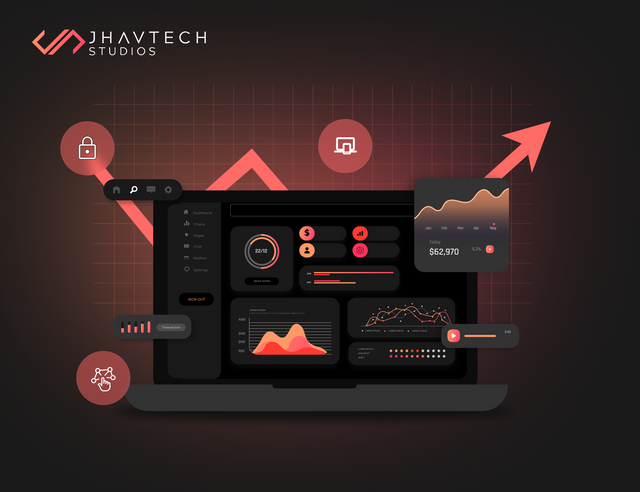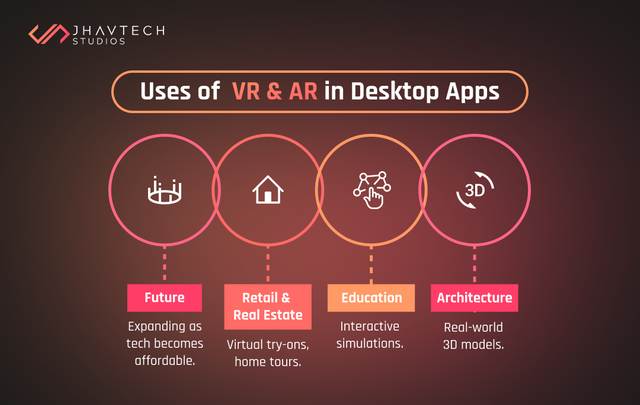.png)
Despite the rise of mobile and web applications, desktop app development remains crucial for sectors like enterprise solutions, gaming, and productivity tools. As technology advances, new trends continue to shape the field. Let’s explore these trends and the opportunities they present for developers.
Cross-Platform Development
One of the most prominent trends in desktop app development is the use of cross-platform tools. Frameworks like Electron, Flutter, and Xamarin enable developers to create applications that work across Windows, macOS, and Linux from a single codebase. This approach reduces development time and cost, streamlining updates and maintenance.
For example, Electron, which powers apps like Slack and Visual Studio Code, shows how cross-platform development supports consistent user experiences. Over 62% of developers now use cross-platform frameworks, underscoring the trend towards universal accessibility. As demand for compatibility across devices grows, cross-platform development is likely to dominate the future of desktop app development, offering seamless user experiences.
Native-Like Experiences
While cross-platform tools are convenient, users still expect desktop applications to deliver high performance and native-like experiences. Native apps are known for their speed and deep system integration, yet cross-platform frameworks are increasingly optimized to deliver similar quality.
Spotify, for instance, is built on Electron but provides performance that competes with native apps, thanks to features like native notifications and platform-specific optimizations. Such advancements mean cross-platform apps can feel just as polished as native ones, ensuring users enjoy a familiar experience across different operating systems.
Progressive Web Apps (PWAs) for Desktop
Progressive Web Apps (PWAs) are becoming more common in desktop environments, bridging the gap between web and native app experiences. Initially popular in mobile and web app development, PWAs combine the accessibility of web apps with the performance of native desktop apps. Technologies like Service Workers and WebAssembly empower PWAs to function offline and offer near-native performance.
Google Docs exemplifies a PWA with full offline functionality, delivering desktop-app-level features. PWAs’ ease of deployment, reduced storage needs, and cross-platform compatibility make them appealing for both desktop and web app development. By 2025, Gartner predicts that PWAs will replace half of native apps, marking them as a key trend in both desktop and web app development.
AI and Machine Learning Integration
AI and Machine Learning (ML) are transforming desktop app development by automating tasks, enhancing interfaces, and personalizing experiences. Applications like Microsoft Word and Google Docs use AI to offer smart writing suggestions, while Grammarly provides context-aware grammar checks.
AI’s impact is also evident in creative industries, where Adobe Photoshop's Content-Aware Fill and Autodesk AutoCAD’s design optimization tools reduce manual effort. Additionally, apps like Dragon NaturallySpeaking use voice recognition to improve accessibility, while AI-driven task management tools help users prioritize tasks based on deadlines and behavior.
As frameworks like TensorFlow and PyTorch become more accessible, more desktop applications will integrate intelligent features. From smarter user interfaces to enhanced productivity tools, AI and ML will make desktop applications more powerful and user-friendly.
Enhanced Security and Privacy
With cybersecurity threats on the rise, security is a top priority in desktop app development. Robust measures—such as multi-factor authentication, data encryption, and secure data storage—are essential, especially in industries that handle sensitive data, like finance and healthcare.
A 2023 report from IBM highlighted that the average cost of a data breach is now $4.45 million. To mitigate such risks, future desktop apps will likely adopt advanced security measures, including biometric authentication and real-time threat detection, to protect user data.
Cloud Integration and SaaS Models
Cloud computing is reshaping desktop app development, especially through Software-as-a-Service (SaaS) models. Cloud-integrated apps allow users to store, share, and access data seamlessly across devices, which is invaluable for collaborative tools and enterprise solutions.
Microsoft Office 365, primarily cloud-based, offers real-time data synchronization and collaboration. By 2025, it’s expected that 85% of enterprise software will be cloud-based, showing the significance of cloud integration in desktop applications. Developers must focus on optimizing for cloud performance and security to meet the demands of today’s users.
Virtual and Augmented Reality in Desktop Apps
.png)
Virtual Reality (VR) and Augmented Reality (AR) are increasingly being integrated into desktop applications beyond gaming. These technologies offer new opportunities in fields like architecture, engineering, and education, where visualization and interaction are essential.
For example, Autodesk Revit uses AR to help architects visualize 3D models in real-world contexts, enabling clients to better understand the spatial relationships of designs. As VR and AR hardware becomes more affordable, desktop applications across various sectors are likely to integrate these immersive technologies, enhancing user engagement and experience.
In education, desktop applications such as zSpace provide students with interactive simulations, allowing them to engage with complex concepts through immersive experiences. From virtual surgeries for medical students to design simulations for engineering, VR and AR in desktop apps offer hands-on learning experiences without the need for physical models.
Sustainability and Energy Efficiency
As awareness of environmental concerns grows, developers are focusing on sustainability in desktop app development. Energy-efficient design is becoming more important, especially in fields where software runs resource-intensive processes for long periods.
To reduce environmental impact, developers are optimizing applications to lower CPU and memory usage. Accenture estimates that green computing could reduce IT energy consumption by 40% by 2025. By prioritizing sustainable development practices, developers can build desktop apps that cater to an eco-conscious user base.
Final Thoughts...
The future of desktop app development is promising, with trends like cross-platform development, AI, security, and cloud integration driving innovation. By keeping pace with these advancements, developers can create applications that are functional, secure, and sustainable, meeting the evolving needs of modern users. Embracing new technologies and focusing on performance, security, and sustainability will help developers build desktop applications that stand the test of time in a digital landscape.